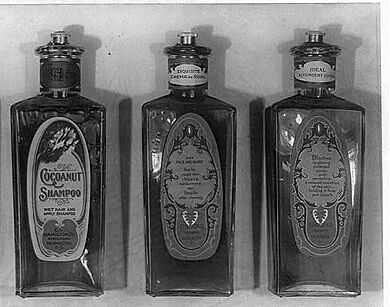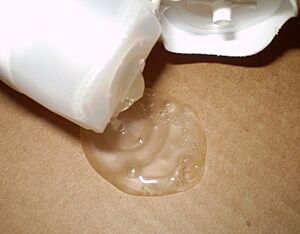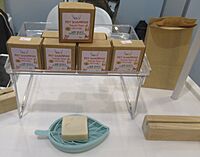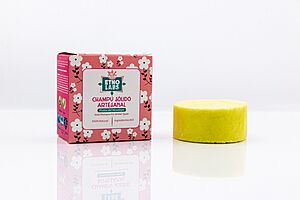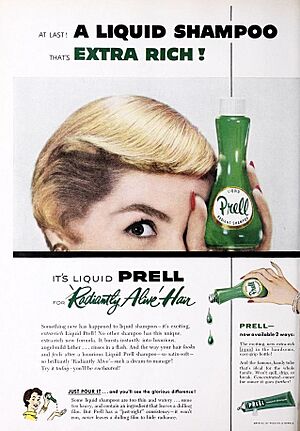Shampoo facts for kids
Shampoo is a product used to clean your hair and scalp. It's usually a thick liquid, but you can also find it in solid bar form. To use it, you wet your hair, rub the shampoo into your hair, roots, and scalp, and then rinse it out. Many people use a hair conditioner afterward.
Shampoo helps remove natural oils (called sebum) and dirt from your hair without making it too dry or hard to manage. Most shampoos are made by mixing a special cleaning ingredient, called a surfactant, with water. These surfactants are similar to what's in soap and help trap oils and dirt so they can be rinsed away.
There are also special shampoos for animals. These might contain medicines to help with skin problems or get rid of parasites like fleas.
Contents
The Story of Shampoo
Early Days in India
The idea of shampoo first came from the Indian subcontinent a very long time ago. People there used different herbs and plant extracts to clean their hair. One early shampoo was made by boiling Sapindus (also called soapberries) with dried Indian gooseberry (amla) and other herbs.
Soapberries have natural cleaning ingredients called saponins, which create a lather. This made hair soft, shiny, and easy to manage. Other plants like shikakai and hibiscus flowers were also used for hair cleansing. The word "shampoo" actually comes from the Hindi word cā̃pō, which means 'to press, knead, or soothe'. This is because hair washing often involved a head massage.
Ancient Times in Mesopotamia
Ancient texts from Mesopotamia show that people there used special shampoos to treat scalp problems.
Shampoo Comes to Europe
An Indian traveler named Sake Dean Mahomed brought the idea of "shampooing" to Britain in 1814. He opened a special bathhouse in Brighton where he offered Indian-style vapor baths and hair treatments. He became famous for these treatments, which he said could help with many health issues.
At first, English hair stylists made their own shampoo by boiling shaved soap in water and adding herbs for shine and fragrance. Commercial shampoos started to appear around the early 1900s. In 1900, a German perfumer, Josef Wilhelm Rausch, created the first liquid hair washing soap. Later, in 1927, another German inventor, Hans Schwarzkopf, made liquid shampoo better for mass production. His name is now a well-known shampoo brand.
Modern shampoo, as we know it today, first appeared in the 1930s with a product called Drene. This was the first shampoo to use man-made cleaning ingredients instead of soap.
Hair Cleaning Around the World
- Indonesia: People in Indonesia used to make shampoo from the husks and straw of rice. They would burn them into ash, mix the ash with water to create a lather, and scrub it into their hair. After rinsing, they would use coconut oil to moisturize their hair.
- Philippines: Filipinos traditionally used gugo, which is the bark of a vine. Soaking and rubbing the bark creates a lather that cleans the scalp.
- North America: Some Native American tribes used extracts from plants like the coastal woodfern to wash their hair.
- South America: Before cooking quinoa, people in the Andes mountains had to wash out a soapy substance called saponin from the grain. They used this soapy water as a shampoo.
Kinds of Shampoo
Shampoos come in different types, each designed for a specific purpose:
- Deep Cleansing Shampoos: These shampoos have more cleaning power and create a lot of foam. They are good for removing extra oil or product buildup. You might see them called volumizing, clarifying, or oil control shampoos.
- Conditioning Shampoos: These shampoos contain ingredients like silicone that help make your hair smooth and soft. They are often called 2-in-1, moisturizing, or color care shampoos.
- Baby Shampoos: These are made with less harsh cleaning ingredients so they are less likely to sting or burn if they get into a baby's eyes. They often say "tear-free" on the bottle.
- Anti-Dandruff Shampoos: These shampoos contain special medicines to help reduce dandruff (flaky scalp). They often have ingredients that fight fungi, like ketoconazole or zinc pyrithione.
What's in Shampoo?
Most liquid shampoos are a mix of a surfactant (the cleaning agent), a co-surfactant, and water. Other important ingredients include salt to make it thick, a preservative to keep it fresh, and fragrance to make it smell nice.
Shampoo makers also add ingredients to make sure the shampoo:
- Foams up nicely
- Rinses out easily
- Doesn't irritate your skin or eyes
- Feels thick and creamy
- Smells good
- Is safe to use
- Doesn't harm your hair
- Helps repair damaged hair
Many shampoos look shiny or pearly. This effect comes from tiny flakes of ingredients like glycol distearate. Some shampoos also include silicone to help condition the hair.
Common Ingredients You Might See
- Sodium Laureth Sulfate: This comes from coconut oils and helps create a good lather.
- Hypromellose: This is used to make the shampoo thicker.
- Sodium Lauroamphoacetate: Also from coconut oils, this helps clean and can make the product "tear-free."
- Citric Acid: This helps keep the shampoo fresh and adjusts its pH level. Shampoos are usually slightly acidic (pH less than 7) because this helps the hair feel smooth and look shiny.
- Polyquaternium-10: This ingredient helps condition the hair, making it feel moisturized and full.
In the United States, shampoo bottles must list all their ingredients. This helps make sure companies are honest about what's in their products and what they claim the shampoo can do.
Special Shampoos
For Dandruff
Shampoos for dandruff contain ingredients that fight the fungi that cause flakes. These can include ketoconazole or zinc pyrithione. Some natural alternatives use tea tree oil or herbal extracts.
For Colored Hair
Many companies make shampoos specifically for hair that has been colored. These shampoos are usually gentler and help protect the hair color from fading. They are a type of moisturizing shampoo.
For Babies
Baby shampoos are made to be very gentle. They are designed so they won't sting or burn if they accidentally get into a baby's eyes. This is done by using milder cleaning ingredients and adjusting the shampoo's pH level to be similar to tears.
Sulfate-Free Shampoos
These shampoos do not contain certain sulfates like sodium lauryl sulfate. They use other natural cleaning ingredients instead.
For Animals
Shampoos for pets like dogs and cats are often made to do more than just clean. They might contain ingredients to treat skin problems, allergies, or to fight fleas. It's important to use pet shampoos only as directed by a veterinarian, as some human shampoos can be harmful to animals if they lick their fur.
Some pet shampoos contain:
- Insecticides: To fight parasites like fleas.
- Antifungals: For yeast or ringworm infections.
- Antibacterials: For bacterial skin infections.
- Antipruritics: To relieve itching from allergies.
- Antiseborrheics: For pets with oily coats or scales.
- Emollients: To add oils and relieve dry, itchy skin.
It's best to choose hypoallergenic pet shampoos without strong fragrances or colors, as these can sometimes irritate a pet's skin.
Solid Shampoo Bars
Shampoo bars are solid versions of shampoo. They can be soap-based or use other plant-based cleaning ingredients mixed with oils and waxes. Soap-based bars can be more alkaline than hair and scalp, which might make hair feel rough.
Jelly and Gel Shampoos
In the past, some shampoos came as stiff, clear gels in tubes. These were thick and couldn't spill easily.
Paste and Cream Shampoos
Shampoos also used to be sold as pastes or creams in jars or tubes. These were wet but not fully dissolved, and they would dissolve quickly when applied.
Antibacterial Shampoos
These shampoos are often used in veterinary medicine or by humans before some surgical procedures to clean and disinfect.
The "No Poo" Movement
The "no poo" movement is a trend where people try to wash their hair less often with traditional shampoo, or use natural alternatives. Some people believe that using shampoo every day can make your scalp produce more oil to make up for what's washed away.
Followers of this movement might use things like baking soda or vinegar to wash their hair. Others use diluted honey, raw eggs, rye flour, or chickpea flour. Some people just rinse their hair with water or use only conditioner.
The idea is that if you gradually use less shampoo, your scalp's oil glands will produce less oil over time, making your hair less greasy. While baking soda can sometimes irritate the skin, natural options like honey and flour are often gentler for long-term use.
See also
 In Spanish: Champú para niños
In Spanish: Champú para niños



